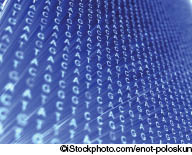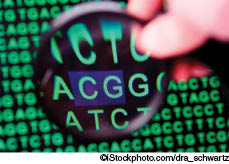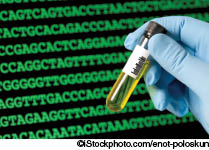
A friend at church told me that in spite of being
taught cellular biology by an outspoken critic of faith, that course
had inspired her to establish a deeper, personal relationship with God.
A course in cell biology can overwhelm a student as the intricate and
animated biochemical world is presented. Many who are devoted to a
purely naturalistic explanation struggle to account for the existence
and function of the coded information in all life. Others just brush
aside the whole problem with a swift stroke of the pen. I am persuaded
that a faith response, like that of my friend, should be a normal
consequence of a person being exposed to the awesome machinery of life.
The existence of information in code form demands the arrival of that
code. Generally, we would think of it as a significant invention. Morse
code, any language, and the computer binary system are examples of
intelligent code systems that we have used to distribute information.
DNA stands out as an efficient, four-character code system.
Suppositions concerning its origin arise from the fact that it exists.
One might imagine that its existence would demand either an origin by
chance or by intentional design. However, many who deny any purpose in
life carefully attempt to rid themselves of dependence on chance.
 They claim that something else
is at work that explains not only the existence of the DNA code but
also its extensive complexity in the entire biosphere. The statistical
probability against the origin of meaningful coded information
demonstrates that chance does not explain our suddenly small universe.
In other words, there simply is not enough material in the universe to
give chance processes a reasonable shot at happening to produce even a
quite small code.
They claim that something else
is at work that explains not only the existence of the DNA code but
also its extensive complexity in the entire biosphere. The statistical
probability against the origin of meaningful coded information
demonstrates that chance does not explain our suddenly small universe.
In other words, there simply is not enough material in the universe to
give chance processes a reasonable shot at happening to produce even a
quite small code.
Literature from those who posture in favor of creation abounds with
examples of the tremendous odds against chance producing a meaningful
code. For instance, the estimated number of elementary particles in the
universe is 1080. The most rapid events occur at an amazing
1045 per second. Thirty billion years contains only 1018
seconds. By totaling those, we find that the maximum elementary
particle events in 30 billion years could only be 10143.
Yet, the simplest known free-living organism, Mycoplasma genitalium, has 470
genes that code for 470 proteins that average 347 amino acids in
length. The odds against just one specified protein of that length are
1:10451.
Even comments from naturalistic scientists demonstrate the uselessness
of chance. French zoologist, Pierre Grasse wrote, “The probability of
dust carried by wind reproducing Durer’s Melancholia (a detailed copper
engraving by the German artist) is less infinitesimal than the
probability of copy errors in the DNA molecule leading to the formation
of the eye … .” Astrophysicist, Fred Hoyle made a quite famous
statement about the probability of a whirlwind assembling a 747. Robert
Shapiro, in a 2007 Scientific
American, wrote, “The analogy that comes to mind is that of a
golfer, who having played a golf ball through an 18-hole course, then
assumed the ball could also play itself around the course in his
absence.” In this analogy, Shapiro pointed out that even if scientists
in their lab demonstrated the possibility of an event, it might not be
reasonable to expect it to happen in nature.
So, with chance out, one might expect that the atheistic explanation is
refuted and God is in. But, whoever relinquished his paradigm just
because it seemed illogical? Stephan Jay Gould wrote, “… life, arising
as soon as it could, was chemically destined to be, and not the chancy
result of accumulated improbabilities.” Origin of life researcher,
Sydney Fox wrote, “… many scientists view natural phenomena as
deterministic, not chancy.” So, if chance cannot accomplish it and you
do not accept the creation alternative, deterministic matter saves the
paradigm. Well, some still linger in the chance camp, but others have
abandoned it guessing that all life must have been destined in matter.
During the Winstar Symposium of 1966 some biologists and mathematicians
clarified the chance problem with no solution in sight. In 1969, Dean
Kenyon and Gary Steinman coauthored Biochemical
Predestination. They coined that phrase and opened a new door
for the atheistic concept of the origin of life. However, after a few
years, Dean Kenyon became discouraged with the lack of evidence for
their brain-child and denounced the concept. A review of their book by
creationist A. E. Wilder-Smith helped him see its fallacy. He soon
became a leader in the Intelligent Design movement. Ironically, many
other biologists latched onto his former concept to save face when
chance failed them.
Chemical predestination of life’s origin and development has no
scientific support. Fred Hoyle and Chandra Wickramasinghe wrote, “If
there were a basic principle of matter that somehow drove organic
systems toward life, its existence should easily be demonstrated in the
laboratory.” Marcel-Paul Schützenberger said, “Some biologists
speak of predestination of the genome. Can anyone actually recover
predestination, supposing it actually existed? ... Confronted with such
questions, the Darwinian paradigm is conceptually bankrupt.” William
Dembski commented, “There’s no sense in which human beings or even
multi-celled organisms are latent in single-celled organisms, much less
in non-living chemicals.” We have the right to question the
justification for such a concept being taught as if it were science.
I have in front of me a magazine in which a photo I took was published.
I can read the photo caption, “Foto Al Cornell.” However, that is all I
can read because the magazine is written in German. I can get a little
information on the content of the magazine from the pictures contained
in it, but I cannot decipher the coded information.
 Every biological organism known
to man is equipped to read the information contained in its DNA. If
that information could not be read, it would be entirely useless. If
chance could produce coded information, meaningful for life, that
information would be totally useless if there were no system in place
to read the code.
Every biological organism known
to man is equipped to read the information contained in its DNA. If
that information could not be read, it would be entirely useless. If
chance could produce coded information, meaningful for life, that
information would be totally useless if there were no system in place
to read the code.
During war, nations develop codes to relay information that the enemy
cannot decipher. During World War II, the United States used Navajo
Indians to transfer confidential information in their native language.
While the enemy went to great pains to try to decipher that code, they
were never able to. Even those of us who know only one language have
invested a significant amount of learning to that end.
The deciphering mechanism for biologically contained information is
amazing. A tightly controlled system is in place to open strands of DNA
at the right place, to produce a transfer RNA copy, and to stop the
production at the necessary spot. The guard holes of the nucleus
membrane open to let the RNA out into the cytoplasm of the cell. The
RNA is joined to a very large molecule called a ribosome. Ribosomes are
present in all living organisms and are necessary to read all
information that is sent out from the DNA.
Again, biological information would hit a dead end, even after being
read, if there were no system in place to utilize the deciphered
information. The ribosome initiates the utilization process by using
the RNA strand that it has read in order to form a specified amino acid
chain for a specific protein.
Formation of the designated protein is just the beginning of the
utilization process. Among the thousands of things constructed from the
DNA information are chambers into which the newly formed amino acid
chains are taken so that each one can properly fold into its necessary
shape for its biological purpose in the organism. Next the protein is
transported to the site where it is needed, and it performs or helps
perform its specified duty among thousands of activities taking place
in the organism.
 If you pick up a newspaper and
read it, you are getting mostly general information. The paper is
designed to keep you informed. Primarily it contains news of events
that have happened. You may learn who won yesterday’s games, who
received an award for what, why Main Street was closed, about births
and death, and about upcoming events. There may be something that
causes you to change a plan or get involved, but most of it is just
general information that you can read and understand.
If you pick up a newspaper and
read it, you are getting mostly general information. The paper is
designed to keep you informed. Primarily it contains news of events
that have happened. You may learn who won yesterday’s games, who
received an award for what, why Main Street was closed, about births
and death, and about upcoming events. There may be something that
causes you to change a plan or get involved, but most of it is just
general information that you can read and understand.
In contrast, while perhaps only 1½ percent of the DNA in an
organism is coded information, every bit of that information is
instructional. It not only has to be read by the organism, but it must
be utilized for the proper structure and functioning of that organism.
“How To” and recipe books give us instructional information. I recently
tried to make a cake. I did not know about the need to keep even a
small amount of yolk out of the egg whites when you beat them. My cake
ended up somewhat flat and heavy. In the world of biological
information, “misunderstanding” can result in serious malfunctions or
premature death.
How can we truly grasp the complexity in a biological system? In Shadows of the Mind: A Search for the
Missing Science of Consciousness, Roger Penrose wrote,
“Biological systems indeed tend to have a subtlety of organization that
far outstrips even the most sophisticated of our (often very
sophisticated) physical creations.” Having a basic concept of this
extraordinarily complex system should boost our confidence that that
system needed intellectual input to get started.
However, that extreme biological organization does not deter the
naturalistic mindset from continuing in its belief system. In Intelligent Design Creationism and Its
Critics, Robert Pennock wrote, “Genetic engineering may one day
allow humans to create life, but so far we do not have a single case of
intelligent creation of life; rather our universal experience to date
is that only unintelligent material processes do so.” I have a hard
time following the logic that if over 1,000 man-years of origin of life
research cannot create life then that means only unintelligent
processes are able to do it. Pennock’s statement is permeated with bias.
One need not read far into the biological literature to find the
inception of life glossed over. Andrew Parker in his book, In the Blink of an Eye, states,
“But once the first protein molecule had assembled, a self-replicating
system would have come into play, which would then develop by natural
selection.” My advice to a baseball coach is do not send a third
baseman in to play before he has undergone conception, birth, and some
development. Of course, my point is that the self-replicating system
would have needed highly sophisticated development before it could have
worked at all. If it were possible for natural selection to work on a
system that had not yet reached the point of having any functional
purpose, it would always work toward eliminating that useless baggage.
The evidence from biological systems lends powerful support to the
viewpoint that there is a God. However, we must walk by faith, and God
leaves some wiggle-room for the unbeliever. This is shown by the irony
of what did and did not prompt faith in God by two former atheists who
came to believe in Him.
In his book, There is a God: How the
World’s Most Notorious Atheist Changed His Mind, Antony Flew
wrote, “It is paradoxical indeed that my first published argument for
atheism was originally presented at a forum presided over by the
greatest Christian apologist of the last century—the Socratic Club
chaired by C. S. Lewis.” He also addresses how the enormous complexity
of DNA and its resulting functions demand creative Intelligence. So
while Flew felt he had satisfactorily answered Lewis, biological
organization was part of the reason for his acknowledging God’s
existence.
In contrast, Francis Collins, who headed the human genome project,
perceives the weight of evidence for faith balanced more away from DNA
and toward C. S. Lewis’ apologetic writings. In The Language of God, he
acknowledges a relationship between God and DNA. He also understands
the inability of modern science to fill the origin of life gap with a
naturalistic explanation, but he thinks that gap may one day be filled
and that it is “not the place for a thoughtful person to wager his
faith.” However, Mere Christianity
by Lewis played a major part in Collins’ path from atheism to faith.
 While it seems ironic that the
DNA person builds faith from Lewis and the person from a Lewis
background finds faith through DNA, I do not want to leave the
impression that they are polarized over an issue. Each has made a
significant contribution to apologetic literature, and, in fact, only
Collins’ endorsement of Flew’s book appears on the front cover of its
dust jacket.
While it seems ironic that the
DNA person builds faith from Lewis and the person from a Lewis
background finds faith through DNA, I do not want to leave the
impression that they are polarized over an issue. Each has made a
significant contribution to apologetic literature, and, in fact, only
Collins’ endorsement of Flew’s book appears on the front cover of its
dust jacket.
However, I do disagree with Collins’ view of some biological gaps. I
think that some gaps, including the one at the origin of life, have
become progressively more defined by research and will ever be a
challenge to the atheistic paradigm.
The agnostic anthropologist, Loren Eiseley, wrote in his book, The Star Thrower, “Only in writing
can the cry from the great cross of Golgotha still be heard in the
minds of men.” Eiseley was influenced by the character and love of
Jesus, but while the New Testament had some instructional influence on
Eiseley’s life, he did not perceive it as a message directing him to
eternal salvation in Jesus Christ by the grace of God. In contrast, the
believer has decided that the New Testament contains significant
instructional information for his life that needs to be understood and
utilized.
Pierre Grasse’s 1977 book, Evolution
of Living Organisms, attacked mainstream evolutionary thinking;
however, what disturbed traditional evolutionists the most was his
final words, “Perhaps in this area biology can go no further: the rest
is metaphysics.” Somewhere there is that “beyond the physical realm.”
Only faith will take you there. Ultimately, Christian faith comes to
rest, not on biologically coded information, but on the written
information of a cross on Golgotha and of an empty tomb.
Back to Contents
Does God Exist?, NovDec09.



 They claim that something else
is at work that explains not only the existence of the DNA code but
also its extensive complexity in the entire biosphere. The statistical
probability against the origin of meaningful coded information
demonstrates that chance does not explain our suddenly small universe.
In other words, there simply is not enough material in the universe to
give chance processes a reasonable shot at happening to produce even a
quite small code.
They claim that something else
is at work that explains not only the existence of the DNA code but
also its extensive complexity in the entire biosphere. The statistical
probability against the origin of meaningful coded information
demonstrates that chance does not explain our suddenly small universe.
In other words, there simply is not enough material in the universe to
give chance processes a reasonable shot at happening to produce even a
quite small code.
 Every biological organism known
to man is equipped to read the information contained in its DNA. If
that information could not be read, it would be entirely useless. If
chance could produce coded information, meaningful for life, that
information would be totally useless if there were no system in place
to read the code.
Every biological organism known
to man is equipped to read the information contained in its DNA. If
that information could not be read, it would be entirely useless. If
chance could produce coded information, meaningful for life, that
information would be totally useless if there were no system in place
to read the code.
 If you pick up a newspaper and
read it, you are getting mostly general information. The paper is
designed to keep you informed. Primarily it contains news of events
that have happened. You may learn who won yesterday’s games, who
received an award for what, why Main Street was closed, about births
and death, and about upcoming events. There may be something that
causes you to change a plan or get involved, but most of it is just
general information that you can read and understand.
If you pick up a newspaper and
read it, you are getting mostly general information. The paper is
designed to keep you informed. Primarily it contains news of events
that have happened. You may learn who won yesterday’s games, who
received an award for what, why Main Street was closed, about births
and death, and about upcoming events. There may be something that
causes you to change a plan or get involved, but most of it is just
general information that you can read and understand. While it seems ironic that the
DNA person builds faith from Lewis and the person from a Lewis
background finds faith through DNA, I do not want to leave the
impression that they are polarized over an issue. Each has made a
significant contribution to apologetic literature, and, in fact, only
Collins’ endorsement of Flew’s book appears on the front cover of its
dust jacket.
While it seems ironic that the
DNA person builds faith from Lewis and the person from a Lewis
background finds faith through DNA, I do not want to leave the
impression that they are polarized over an issue. Each has made a
significant contribution to apologetic literature, and, in fact, only
Collins’ endorsement of Flew’s book appears on the front cover of its
dust jacket.